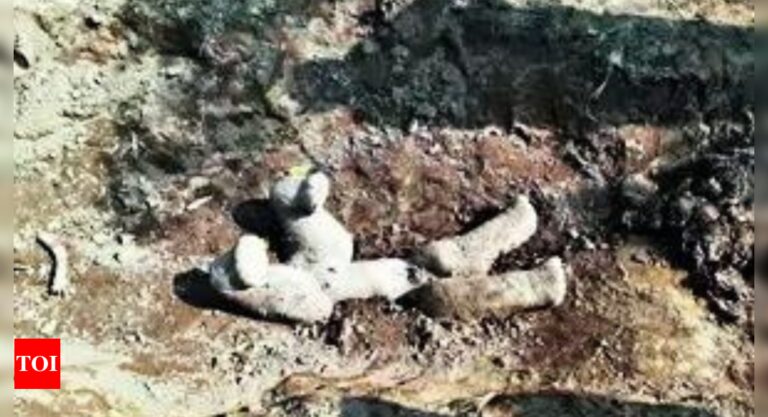
[ad_1]
KOLKATA: The deceptively ponderous and gigantically affectionate Asian elephant has been documented – for the first time – burying calves who die prematurely.
This behaviour earlier found mention in African literature, presumably referring to the larger elephant species from that continent.
The findings of multiple case studies have excited experts who study social behaviour in animals, as ‘calf burial’ has only ever been documented in a species of termite, but not in mammals.
In five case studies in north Bengal, herd members dragged the calves away from human settlements before burying them in “leg-upright position” in irrigation trenches inside tea gardens.
‘Jumbos avoid paths where carcasses of calves are buried’
The study was published in the internationally acclaimed Journal of Threatened Taxa.
“The study area covered fragmented forests, tea estates, agricultural lands and military establishments between 2022 and 2023,” said Parveen Kaswan, DFO of Jaldapara wildlife division, formerly DFD of Buxa Tiger Reserve, who co-authored the study with Akashdeep Roy, a senior research fellow at IISER Pune. “We explained burial strategy of elephants in irrigation drains of tea estates by presenting five case reports,” he added.
“We found that the elephants carry the carcasses, holding on to the trunks or legs, for a distance before burying them,” Kaswan told TOI. “Direct human intervention was not recorded in any of the five deaths. Through long-term observation, we also found that the elephants in this region avoided paths where carcasses were buried.”
The cases have been documented in Debpara, Chunabhati, Bharnabari, Majherdabri and the New Dooars tea gardens near Gorumara and Buxa. The calves were aged between three and 12 months.
Most surprising, according to the study, is the positioning of the carcasses that are buried: in all five cases, the legs were upright, with the head, trunk and dorsal regions fully buried. “The positioning could be explained for better grip for herd members to hold and lay the calf in the trench. This behaviour also reflects the care and affection of the entire herd for the dead calf. It suggests that because of a space crunch, the herd members prioritise the head for burial before feet,” added Kaswan. While burying each carcass, members of the elephant herd “vocalised” for about 30-40 minutes. This may signify mourning, the researchers conjecture, though more study needs to be done to explain this, they said.
According to long-term observation, elephant movement frequency had reduced by up to 70% in these areas. “Jumbos started using parallel pathways, clearly avoiding the previous path where carcasses were buried,” the study claims, adding that this behaviour contrasted with that of African elephants, who spend a lot of time investigating and exploring the remains.
This behaviour earlier found mention in African literature, presumably referring to the larger elephant species from that continent.
The findings of multiple case studies have excited experts who study social behaviour in animals, as ‘calf burial’ has only ever been documented in a species of termite, but not in mammals.
In five case studies in north Bengal, herd members dragged the calves away from human settlements before burying them in “leg-upright position” in irrigation trenches inside tea gardens.
‘Jumbos avoid paths where carcasses of calves are buried’
The study was published in the internationally acclaimed Journal of Threatened Taxa.
“The study area covered fragmented forests, tea estates, agricultural lands and military establishments between 2022 and 2023,” said Parveen Kaswan, DFO of Jaldapara wildlife division, formerly DFD of Buxa Tiger Reserve, who co-authored the study with Akashdeep Roy, a senior research fellow at IISER Pune. “We explained burial strategy of elephants in irrigation drains of tea estates by presenting five case reports,” he added.
“We found that the elephants carry the carcasses, holding on to the trunks or legs, for a distance before burying them,” Kaswan told TOI. “Direct human intervention was not recorded in any of the five deaths. Through long-term observation, we also found that the elephants in this region avoided paths where carcasses were buried.”
The cases have been documented in Debpara, Chunabhati, Bharnabari, Majherdabri and the New Dooars tea gardens near Gorumara and Buxa. The calves were aged between three and 12 months.
Most surprising, according to the study, is the positioning of the carcasses that are buried: in all five cases, the legs were upright, with the head, trunk and dorsal regions fully buried. “The positioning could be explained for better grip for herd members to hold and lay the calf in the trench. This behaviour also reflects the care and affection of the entire herd for the dead calf. It suggests that because of a space crunch, the herd members prioritise the head for burial before feet,” added Kaswan. While burying each carcass, members of the elephant herd “vocalised” for about 30-40 minutes. This may signify mourning, the researchers conjecture, though more study needs to be done to explain this, they said.
According to long-term observation, elephant movement frequency had reduced by up to 70% in these areas. “Jumbos started using parallel pathways, clearly avoiding the previous path where carcasses were buried,” the study claims, adding that this behaviour contrasted with that of African elephants, who spend a lot of time investigating and exploring the remains.
[ad_2]
